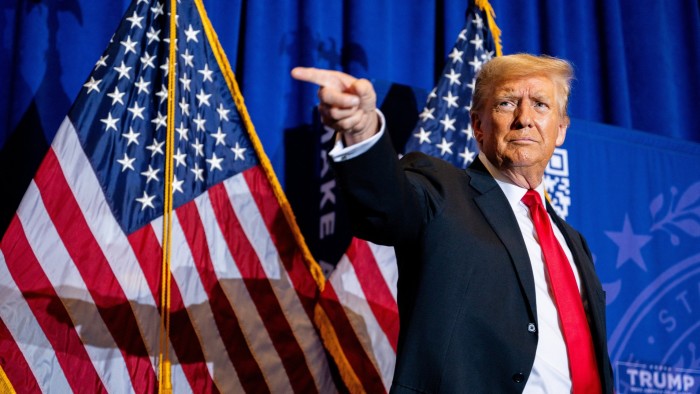Unlock the Editor’s Digest for free
Roula Khalaf, Editor of the FT, selects her favourite stories in this weekly newsletter.
Donald Trump spent time on the campaign trail advocating a weaker dollar, imagining this would be the key to unlocking a great renaissance in American manufacturing.
We should give the man his due. Few thought it was possible to pull the world’s most important currency lower, pointing to the US’s long-running dominance over the global economy and markets. And yet through the magic of radical uncertainty and the erosion of America’s foundational values and institutions, he has succeeded in engineering a 7 per cent decline. A masterful gambit.
Whether this helps at all with the effort to support US industry is a question for the long term. The bet right now has to be “not really”, given all the other impediments to companies — especially foreign ones — investing in people and equipment in the US in this age of heightened uncertainty. But that is not the element that investors are thinking about currently. Instead, Trump has turned fund managers all over the world into currency traders, whether they like it or not.
Many stock investors have barely thought about foreign exchange risk for years. Why bother? During the American exceptionalism era of 2010 to 2024, US-based investors overwhelmingly put money to work at home. They were riding the Big Tech wave to dizzying heights and taking a close to zero chance that a blow-up in famously unpredictable currency markets could leave a mark on the value of their investments. Jim Caron at Morgan Stanley Investment Management tells me that a lot of his clients have as little as 3 per cent of their portfolios invested outside the US — a proportion he is encouraging people to increase.
Elsewhere, investors rode the same Big Tech wave but also a smooth 40 per cent ascent in the dollar, on the Federal Reserve’s trade-weighted measure.
It is tricky to figure out the precise degree to which non-US investors had shielded themselves against a bout of dollar weakness in recent years. Obviously every portfolio is different, but hedging rates appear to be low. Analysis from BNP Paribas, for instance, suggests that hedging rates on dollar assets held by Dutch and Danish pension funds have recently sunk to, or close to, record lows. The bank reckons the Eurozone pension fund industry holds as much as $770bn in unhedged dollar exposure.
Market movements so far in 2025 have focused the mind here. US stocks have recovered handily since the tariffs-related shock of early April, dragging the main index, the S&P 500, into positive territory for the year so far. But that is in dollars. In euro terms, the index is still down by more than 7 per cent this year, as the buck has fallen due to expectations of US economic weakness but also because of the broad evaporation of trust in American institutions under Trump 2.0. So much for the counterbalance of the dollar’s reserve currency status — that is struggling under the new regime.
Meanwhile, European stocks are performing very nicely, in part due to the new German government’s intentions to spend its way out of trouble, combined with an accommodative central bank. In dollar terms, though, the performance is even more sparkling, enabling dollar-based investors brave enough to venture overseas to amplify returns.
Now, analysts often say the top question they are receiving from investor clients is how to manage the risk that the dollar could keep falling and eating into their portfolios.
Stock and bond investors know that the stocks and bonds they buy can go down as well as up. (If they don’t, they should probably find another job.) This is still the biggest risk to portfolios. But analysis from Canadian bank RBC shows that currency-specific risk, as a slice of overall portfolio risk, is rising across the world outside the US, especially in Europe, Australia and Canada, with the US dollar accounting for the bulk. For euro-based investors, currency movements account for nearly one-third of total risk — way beyond the currency sensitivity of US-based investors.
How investors deal with this depends on where they are. It is easier, and less costly, to hedge in bigger, more actively traded currencies, for example. But RBC reckons that a 5 per cent increase in dollar hedges would add up to some $2tn worth of dollar selling over time.
A massive, sudden drop in the dollar would be bad news for a number of reasons but would at least make US assets and exports look like a bargain. But we are not there yet. Instead, gradual, lasting dollar weakness is just another reason for investors to doubt that American exceptionalism can make a comeback, and to keep a growing slice of future allocations at home.
Read the full article here




